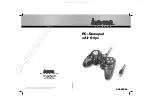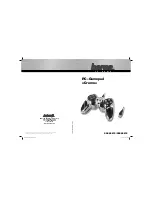
Warner Electric • 800-825-9050
P-2003-2 • 819-0420
5
o
4 . Attach conduit or seal tight connectors .
The control is now ready to be wired . Refer to the
wiring section of this manual for proper system wiring .
Brake Installation
Refer to the brake manual that is appropriate for the
brake selected for its installation procedures .
External Sensor Mounting (Optional)
Options for four types of external sensor inputs are
available . These consist of either an external torque
adjust, roll follower input that provides a signal
directly proportional to the diameter of the roll to be
processed, analog voltage, or analog current input .
Determine which type of external sensor will be
used and proceed to the appropriate section of this
manual .
Remote Torque Adjust Potentiometer (Optional)
o
1 . Select an appropriate mounting location for the
external torque-adjust potentiometer .
Note:
In determining this mounting location, take
into consideration the routing of the wires necessary
to connect the control, access for the operator,
and space required by the physical size of the
potentiometer .
o
2 . Drill a mounting hole based on the bushing
diameter of the potentiometer selected .
o
3 . Mount and secure the potentiometer .
This completes the mounting for an external remote
torque adjust potentiometer . Refer to the wiring
section of this manual for proper control wiring .
Roll Follower Adjust Potentiometer (Optional)
o
1 . Mount the roll follower potentiometer and
determine the amount of angular rotation at the
potentiometer shaft .
Note:
If angular rotation is not adequate, insufficient
output from the control is possible . In this case, a
timing belt drive between the roll follower pivot-point
and the sensor potentiometer may be necessary to
obtain adequate angular rotation .
o
2 . Secure the roll follower potentiometer . This
completes the mounting for a roll follower
potentiometer . Refer to the wiring section of this
manual for proper control wiring .
Analog Input (Optional)
o
1 . Select an appropriate mounting location for the
PLC or ultrasonic sensor .
o
2 . Mount and secure the PLC or ultrasonic
sensor according to the specifications for those
products .
This completes the mounting . Refer to the wiring
section of this manual for proper control wiring .
System Wiring
System Wiring Precautions
The following wiring precautions will help you
properly wire and install a trouble free system .
o
1 . Use a proper gauge wire for all wiring .
o
2 . Insure that wires are cut and stripped so that
no excess bare wire is exposed .
o
3 . Segregate AC input power from control
switching and external sensor wiring (if used) .
o
4 . Do not run AC power lines with DC power,
input sensor wiring, or switching wiring . Noise
transients can be easily transferred, causing
erratic control operation .
o
5 . Use shielded cable when possible for
connecting the TCS-200-1 to external switches,
the sensor potentiometer, PLC’s, and ultrasonic
sensor .
o
6 . Under no circumstances should auxiliary
accessories be operated from the TCS-200-1
control .






































